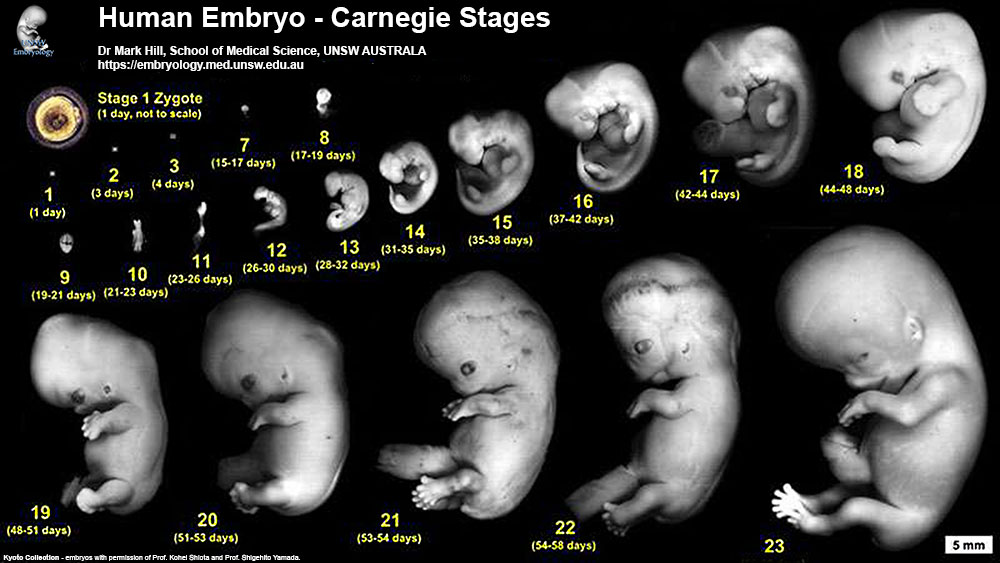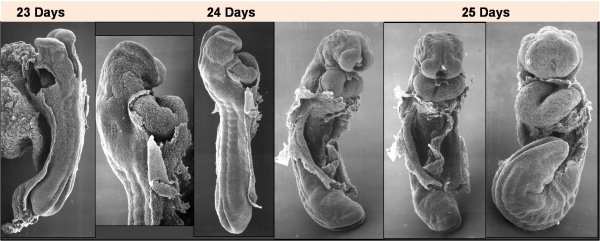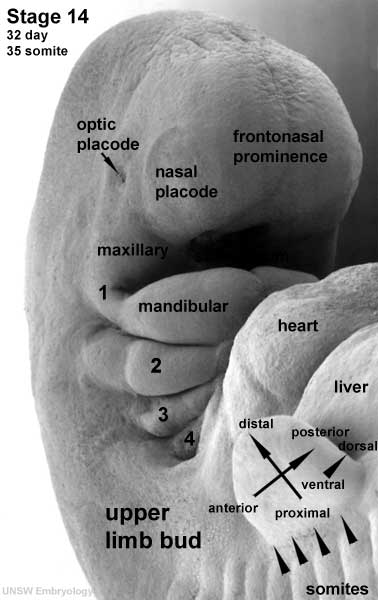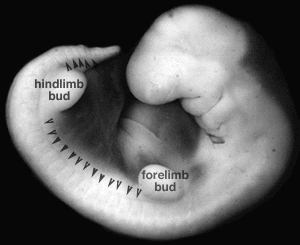2010 BGD Lecture - Development of the Embryo/Fetus 2: Difference between revisions
No edit summary |
|||
| Line 71: | Line 71: | ||
===Somitogenesis=== | ===Somitogenesis=== | ||
[[File:Stage11 sem100c.jpg||thumb|stage 11 Embryo]] | [[File:Stage11 sem100c.jpg||thumb|stage 11 Embryo]] | ||
Revision as of 21:38, 10 May 2010
Introduction
--Mark Hill 20:54, 3 May 2010 (EST) I am currently updating the notes that will appear here for 2010. Previous 2008 Lecture
This lecture covers the period of Embryonic development, in Humans from week 3 to week 8 and is divided into 23 Carnegie stages of embryonic development. There will also be a brief introduction to fetal development.
This period of development will also be covered in your Practical, which is currently being updated for 2010 and will be available online. Note, the period from week 9 to week 38 is considered Fetal development and will be covered in detail in the Laboratory 11.
- Embryonic Development
- Organ and System formation (Functioning / Not Functional)
- Dynamic changes internal and external
- Carnegie stages illustrate external development
First 8 Weeks
Week 3
Mesoderm means the "middle layer" and it is from this layer that nearly all the bodies connective tissues are derived. In early mesoderm development a number of transient structures will form and then be lost as tissue structure is patterned and organised. Humans are vertebrates, with a "backbone", and the first mesoderm structure we will see form after the notochord will be somites.
Facts: Week 4, 22 - 23 days, 2 - 3.5 mm, Somite Number 4 - 12
View: This is a dorsal view of the human embryo, the amniotic membrane has been removed. Top embryo is an early stage 10, bottom is late stage 10.
Mesoderm organization: lateral plate - intermediate mesoderm - paraxial mesoderm - axial mesoderm - paraxial mesoderm - intermediate mesoderm - lateral plate
Axial Mesoderm
- notochord
- mechanical role in embryonic disc folding
- molecular role in patterning surrounding tissues
Adult - contributes to the nucleus pulposis of the intervertebral disc
Paraxial Mesoderm
- differentiates rostro-caudally (head to tail)
- remains unsegmented in the head region.
- segments in the body region to form pairs of somites along the length of the embryo.
Adult - contributes vertebral column (vertebra and IVD), dermis of the skin, skeletal muscle of body and limbs
Intermediate Mesoderm
- named by position (between paraxial and lateral plate)
- differentiates rostro-caudally (head to tail)
- forms 3 sets of "kidneys" in sequence
- pronephros
- mesonephros
- metanephros
Adult - metanephros forms the kidney
Lateral Plate Mesoderm
- a "horseshoe shaped" space forms in the middle
- somatic mesoderm - closest to ectoderm
- space - forms the 3 body cavities (pericardial, pleural, peritoneal)
- splanchnic mesoderm - closest to endoderm
Adult - body connective tissues, gastrointestinal tract (connective tissues, muscle, organs), heart
Somitogenesis
Somite initially forms 2 main components
- ventromedial- sclerotome forms vertebral body and intervertebral disc
- dorsolateral - dermomyotome forms dermis and skeletal muscle
Heart
Head
Upper and Lower Limb
Limb development occurs at different times for forelimbs and hindlimbs. In the mid-4th week, human upper limb buds first form and lower limbs about 2 days later. The limbs form at vertebra segmental levels C5-C8 (upper limbs) L3-L5 (lower limbs).
Glossary Links
- Glossary: A | B | C | D | E | F | G | H | I | J | K | L | M | N | O | P | Q | R | S | T | U | V | W | X | Y | Z | Numbers | Symbols | Term Link
- 2010 BGD: Lecture 1 | Lecture 2 | Practical 3 | Practical 6 | Practical 12
Cite this page: Hill, M.A. (2024, May 17) Embryology 2010 BGD Lecture - Development of the Embryo/Fetus 2. Retrieved from https://embryology.med.unsw.edu.au/embryology/index.php/2010_BGD_Lecture_-_Development_of_the_Embryo/Fetus_2
- © Dr Mark Hill 2024, UNSW Embryology ISBN: 978 0 7334 2609 4 - UNSW CRICOS Provider Code No. 00098G
















